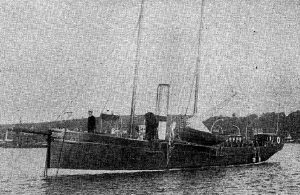
A yacht belonging to Charles Wells, the man who broke the bank, pictured in 1912 at Falmouth.
After committing bank fraud on a huge scale in Paris, in 1910-11, Charles Deville Wells (the man who broke the bank) escaped to England and lived on a yacht in Falmouth harbour. Moorings were provided by a local shipbuilding company, Cox & Co., who even received Wells’ mail on his behalf, and who almost certainly carried out work to the yacht, which Wells was always improving.
When Wells was finally arrested on the vessel, in early 1912, he was charged in the presence of a Justice of the Peace, Arthur William Chard.
Chard also had connections with marine engineering, and I mention in the book that he and the owner of Cox & Co. were evidently acquainted: ‘… on at least one occasion the two men had jointly presided over the committee which investigated wrecked and missing ships.’ I make the point that Wells was also passionate about ships and the sea, and – in other circumstances – the three men would probably have got along famously together.
An additional piece of information has come to light. Yesterday I found this on the simplonpc.co.uk website. It concerns the River Fal Steamship Company and shows that there was a further connection between Chard and Cox , which I hadn’t previously been aware of.
‘In 1899, William John Thomas, in partnership with Arthur William Chard, ordered a second smaller passenger steamer Victoria (1), delivered in 1900 from Cox & Co. Unlike the rival Benney & Co steamers, she was twin screw with a lower draft. Within six months she was sold back to her builder Walter Cox, who had a buyer ready in Mauritius. Cox delivered the replacement Victoria (2) in 1901, also twin screw. The partners adopted the title The River Fal Steamship Company. Victoria (2) was similar to her predecessor, but had a small upper deck. Both steamers had buff funnels and white hulls. In 1905, the Victoria (2) was also sold to the Portuguese Government. Once again, a replacement was ordered from Cox & Co, becoming the Princess Victoria in the combined fleet with Benney & Co in 1907.’
My thanks to Ian Boyle who runs the site, simplonpc.co.uk , which contains some very interesting material and is well worth a look!
